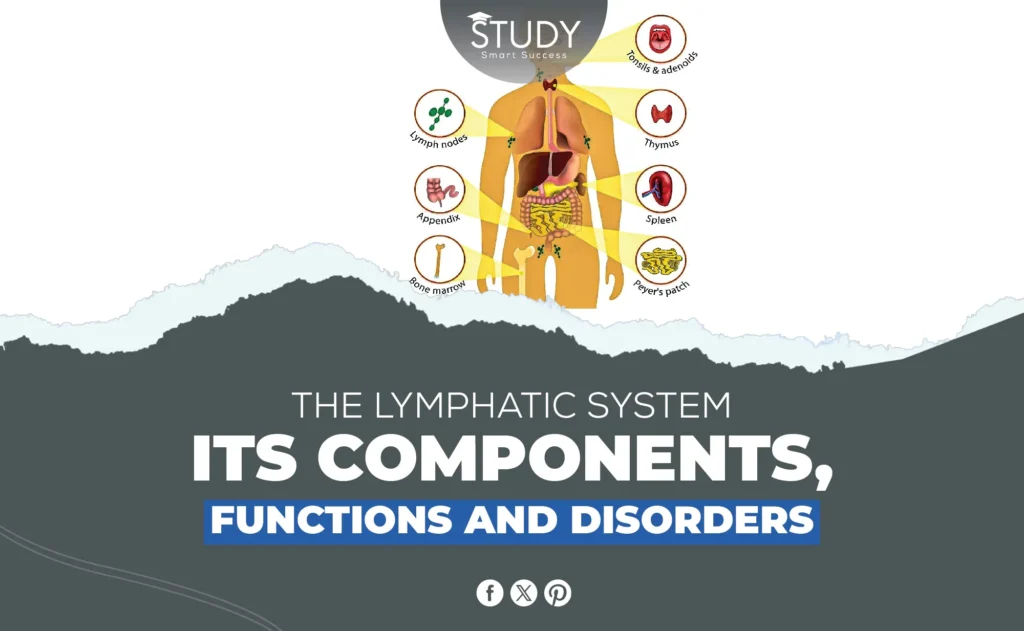Introduction
The lymphatic system is often underestimated but crucial to our health. Did you know that without a healthy lymphatic system, our systems would struggle to fight infections and maintain fluid balance, potentially causing death? This complex network protects our immune system and maintains our inside environment.
The lymphatic system’s intricate tubes, nodes, and organs remove waste, poisons, and other substances from the body. It helps absorb dietary lipids and maintain fluid equilibrium, which is essential to human health.
This article covers the lymphatic system’s parts, functioning, and joint problems. By the conclusion, you’ll know how this system promotes your health and what happens when it doesn’t.
Read more about the Endocrine System of the human body.
What is the Lymphatic System?
The lymphatic system, which includes lymphatic veins, lymph nodes, and organs, is essential to the body’s immune system. It carries lymph, a clear fluid with white blood cells, throughout the body. This system eliminates toxins, waste, and other substances, maintaining fluid balance and preventing infections.
The lymphatic system supplements the circulatory system, which supplies oxygen and nutrients. Unlike the circulatory system, which uses the heart, the lymphatic system circulates lymph through muscles and tissues. Lymph flows from tissues to the heart through the lymphatic system, unlike blood, which circulates in a closed loop. This distinction shows that the lymphatic system uniquely functions in immunological defense and fluid management.
Main Components of the Lymphatic System
Lymphatic Vessels
Like blood arteries, lymphatic vessels are thin-walled tubes that flow throughout the body. Their main job is to return lymph, a clear fluid carrying immune cells, debris, and other things, to the bloodstream. Lymphatic capillaries in cell spaces become these channels. They merge into bigger lymphatic vessels and drain into the thoracic and right lymphatic ducts, which flow into the heart’s subclavian veins.
Lymphatic Capillaries
The lymphatic system’s tiniest vessels and capillaries absorb interstitial fluid from tissues. Fluid from blood capillaries contains water, nutrients, and waste. The lymphatic capillaries absorb this fluid and any foreign particles or pathogens, carrying it as lymph through the lymphatic vessels to be filtered and returned to the bloodstream.
Lymph Nodes
Small, bean-shaped lymph nodes are seen in the neck, armpits, and groin. They filter lymph fluid in lymphatic channels. Immune cells in lymph nodes trap and kill bacteria, viruses, and cancer cells, preventing infections.
Function in Immune Response
Lymph nodes are crucial to immunity. White blood cells called lymphocytes fight infections. Lymph nodes swell when they create more lymphocytes. This adaptive immune response helps the body target certain infections.
Lymph
Lymph circulates in the lymphatic system and is transparent to yellowish. It contains proteins, lipids, garbage, and white blood cells (primarily lymphocytes). Lymph nodes remove germs and viruses from lymph fluid.
Role in the Body
Lymph primarily transport nutrients and waste between tissues and blood. It also transports intestinal proteins, lipids, trash, and foreign particles. Lymph circulates through the lymphatic system to maintain fluid balance, boost immunological function, and remove pollutants.
Thymus
The thymus is a tiny gland behind the sternum in the upper chest. It is essential to the immunological system, especially in children and adolescents. The thymus develops and matures T-cells, which are essential to adaptive immunity. T-cells recognize and attack infections and regulate other immune responses.
Spleen
The spleen is in the upper left abdomen. It performs various vital activities. This organ filters blood, eliminating old or damaged red blood cells and recycling their parts. White blood cells and platelets are discharged from the spleen as needed. In addition, the spleen produces and stores lymphocytes that fight infections.
Tonsils and Adenoids
The tonsils and adenoids, lymphoid tissues at the back of the throat and nasal cavity, respectively, are the body’s first line of defense against pathogens entering through the mouth and nose. They trap bacteria, viruses, and other foreign particles, preventing infections, and contain immune cells to start the immune response.
Functions of the Lymphatic System
Fluid Balance
The lymphatic system is essential for fluid homeostasis. As blood circulates, some blood spills from blood vessels into surrounding tissues. The interstitial fluid contains nutrition, oxygen, and waste. The lymphatic system absorbs extra fluid through lymphatic capillaries and returns it to circulation. Tissue fluid collection can result in edema, but this mechanism prevents it.
Immune Defense
The lymphatic system helps the immune system fight infections and illnesses. It carries lymph, which contains white blood cells, especially lymphocytes. Lymphatic veins include lymph nodes that filter lymph fluid, removing bacteria, viruses, and foreign particles. Immune cells in lymph nodes kill these intruders, preventing disease.
Absorption of Dietary Fats
The lymphatic system helps digested lipids be absorbed. Once fats are broken down, lacteals in the small intestinal lining absorb them. Fats travel through the lymphatic system and into the bloodstream, allowing optimal body absorption and distribution of dietary lipids.
Removal of Waste Products and Toxins
The lymphatic system removes waste and poisons from tissues. Lymph gathers waste, dead cells, and poisons from tissues as it circulates. Immune cells filter and degrade these chemicals in the lymph nodes. The cleaned lymph returns to the bloodstream, keeping the body clean.
Transport of White Blood Cells
The lymphatic system transports white blood cells, especially lymphocytes, throughout the body. These immune cells detect and fight pathogens like bacteria and viruses that enter the body. The lymphatic system quickly mobilizes the immune response to battle infections by circulating lymphocytes through lymphatic arteries and nodes.
Common Disorders of the Lymphatic System
1. Lymphedema
People with lymphedema often have swollen tissues in their arms or legs. This swelling happens when lymphatic fluid builds up in the tissues because lymphatic veins are blocked or not working correctly, preventing the fluid from draining properly.
Causes:
Lymphedema can be caused by problems present at birth (primary lymphedema) or harm to the lymphatic system (secondary lymphedema). Most often, surgery, radiation treatment, infections, or trauma that hurts the lymphatic vessels or nodes leads to secondary lymphedema.
Symptoms:
Symptoms include chronic swelling, a heavy or tight feeling in the affected limb, a limited range of motion, and persistent infections. Fibrosis is when skin becomes thick and stiff over time.
Management:
Manual lymphatic drainage, a type of massage, compression clothing, exercise, and good skin care to avoid getting infections are all ways to deal with lymphedema.
2. Lymphadenopathy
Lymphadenopathy occurs when lymph nodes get bigger. This can happen because of an illness, an autoimmune disease, or cancer. Often, swollen lymph nodes mean the body is fighting off an infection or sickness.
Causes:
Some of the most common reasons are bacterial or viral infections (like the common cold, strep throat, or mononucleosis), inflammatory conditions (like rheumatoid arthritis), and cancers (like lymphoma or cancer that has spread).
Symptoms:
Often, lymph nodes that are swollen and painful to touch are because of an illness. When there is cancer, the nodes may be complex, set, and not painful.
Treatment:
Treatment depends on the cause. Infections are treated with antibiotics or antivirals, whereas autoimmune disorders may require immunosuppression. Cancer diagnosis and treatment may require chemotherapy or radiation.
3. Lymphoma
Lymphoma is a type of cancer that starts in the lymphatic system, specifically in lymphocytes, a type of white blood cell. Hodgkin lymphoma and non-Hodgkin lymphoma are the two main types of lymphoma.
Hodgkin Lymphoma:
Reed-Sternberg cells are a sign of Hodgkin lymphoma, a cancer that usually starts in the lymph nodes but can spread to other parts of the body.
Non-Hodgkin Lymphoma:
There are many different kinds of cancer in this group. They can start in different parts of the lymphatic system and spread in less predictable ways.
Symptoms and Treatment:
Lymphoma symptoms include lymph nodes that swell up without pain, weight loss that you can’t explain, fever, night sweats, and tiredness. Depending on the type and stage of lymphoma, chemotherapy, radiation treatment, targeted therapy, and stem cell transplantation can help.
4. Lymphangitis
Inflammation of the lymphatic vessels is called lymphangitis. A bacterial illness usually causes it. Bacteria often get into the lymphatic system through a cut or sore on the skin.
Symptoms:
Red lines on the skin that go from the infection site to the closest lymph nodes are signs. People also get fevers, chills, and a feeling of being sick. The hurt spot might also be sore and swollen.
Treatment:
Antibiotics are usually used to treat lymphangitis and eliminate the infection. Painkillers and anti-inflammatory drugs can also help ease the effects. In the worst cases, draining a cyst may be necessary, or doctors may need surgery to prevent the infection from spreading.
Conclusion
The lymphatic system supports immune defense and removes waste. Understanding its parts and functions helps us realize its importance to our health. However, like any body system, the lymphatic system can develop problems like lymphedema, lymphadenopathy, lymphoma, and lymphangitis, which can have serious health consequences if not appropriately handled.
Knowing these illnesses and their symptoms allows people to seek early medical treatment and promote their lymphatic health. A healthy lymphatic system is essential to general health through nutrition, exercise, or medicine.


